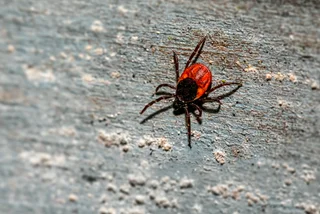With summer weather of up to 25 degrees Celsius this week, current conditions are ideal for outdoor activities -- as well as ticks. The ticks native to the Czech Republic can transmit Lyme disease and tick-borne encephalitis to humans.
Due to these potential dangers, the Czech Hydrometeorological Institute (ČHMÚ) publishes a daily map of tick activity, and currently, as of Monday, tick activity in the Czech Republic is at its highest, i.e. the fifth level of "extreme" risk, for the next two days.
If you're planning to be outside you can track tick activity here, we've put together an explainer on what the map means in English and how to take precautions, and when to avoid the outdoors entirely. Currently, the ČHMÚ recommends using a repellant or avoiding deciduous and mixed forests entirely.
#biopredpoved Na celém územà Česka panuje mimořádné riziko napadenà klÃÅ¡tÄ›tem.
— ÄŒeský hydrometeorologický ústav (ÄŒHMÚ) (@CHMUCHMI) May 29, 2023
DoporuÄenÃ:
Použijte repelent. Nevstupujte volnÄ› do listnatých a smÃÅ¡ených lesů, pohyb pouze po zpevnÄ›ných cestách.
Sledujte vývoj v dalÅ¡Ãch dnech: https://t.co/c1IK8y6wVW pic.twitter.com/4yfaf1LAkA
Levels of tick activity
- Level 1 = low risk: When visiting leafy and mixed wooded areas with herbaceous bushes and vegetation, choose clothes made of smooth, light-colored fabric and occasionally inspect and possibly remove attached ticks, especially from pants. (The same precautions should be taken for other levels of risk). Do an evening and morning body inspection to check for ticks.
- Level 2 = moderate risk: Use repellent, do not sit or lie down in the vegetation. Do an evening and morning body inspection to check for ticks.
- Level 3 = medium risk: Use repellent, do not sit or lie down in vegetation, and do walk through brush or bushes. Do an evening and morning body inspection to check for ticks.
- Level 4 = high risk: Use repellent, do not sit or lie down in thickets, and avoid brush or herbaceous vegetation, especially at the edge of the forest, or at the edge of water sources, and leafy overgrowth. Do an evening and morning body inspection to check for ticks.
- Level 5 = extreme risk: Use repellent. Do not freely enter deciduous and mixed forests, and move only on paved roads. Do an evening and morning body inspection to check for ticks.
Why is tick activity increasing?
"Thanks to milder winters, more ticks survive, and in the spring they become more active earlier – for example, this year they woke up already in February," Kateřina Kybicová, head of the Lyme disease reference laboratory at the National Institute of Public Health (SZÚ), told news server Deník N.
"They also remain active longer into the late fall months. This prolongs the time when there is a risk of infection," she added.
How to detect a tick bite
Even if you still discover a tick after taking precautions, experts recommend covering the area of the bite and the tick itself with an alcohol-based disinfectant and letting it soak for a couple of minutes. Avoid applying any type of oil or ointment. After disinfecting the area, use small tweezers to remove the tick by grasping it as close to the skin as possible and using a gentle side-to-side motion to carefully remove it.
According to preliminary data from the SZÚ, 416 people were infected with tick-borne borreliosis, also called Lyme disease, this year by the end of April. Last year in the same period doctors recorded 279 patients. There were approximately the same number of cases of tick-borne encephalitis, 13 this year and 12 last year.
Anyone who is bitten by a tick and starts to experience flu-like symptoms within four days up to two weeks should see a doctor. Symptoms to be concerned about include fever, headache, muscle ache, fatigue, and malaise. Keep an eye on the site of the bite, and if a red area with a diameter of 3–5 cm develops, seek immediate medical attention.
According to public health insurer VZP's web pages, all people over the age of 50 (who have Czech health insurance) are entitled to free vaccination against tick-borne encephalitis. The standard price for this vaccine is around CZK 800–900. Health insurance companies reimburse for varying amounts. Czech public health insurance, for instance, reimburses CZK 500 to adults over 18 and CZK 700 for children under 18.













 Reading time: 3 minutes
Reading time: 3 minutes 

































